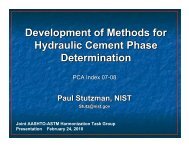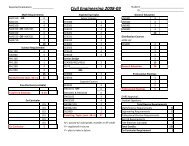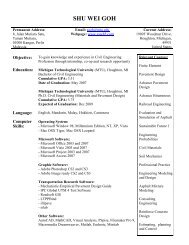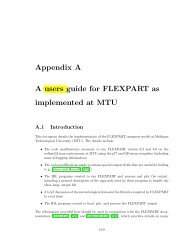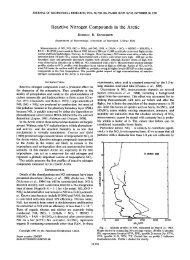Evaluation of Septic Tank and Subsurface Wetland for
Evaluation of Septic Tank and Subsurface Wetland for
Evaluation of Septic Tank and Subsurface Wetland for
Create successful ePaper yourself
Turn your PDF publications into a flip-book with our unique Google optimized e-Paper software.
Table 5-5 Nitrate (NO3-N) <strong>for</strong> Pisgah <strong>and</strong> Retrieve Sanitation Systems<br />
________________________________________________________________________<br />
Sample Arithmetic Mean 90% Confidence Sample<br />
( X ) mg/l Interval mg/l Size (n)<br />
Pisgah First <strong>Septic</strong> <strong>Tank</strong> 0.2 X ± 0.1<br />
5<br />
Pisgah Wetl<strong>and</strong> Influent 0.5 X ± 0.3<br />
5<br />
Pisgah Wetl<strong>and</strong> Effluent 0.7 X ± 0.4<br />
4<br />
Retrieve First <strong>Septic</strong> <strong>Tank</strong> 0.4 X ± 0.3<br />
6<br />
Retrieve Wetl<strong>and</strong> Influent 0.4 X ± 0.3<br />
6<br />
Retrieve Wetl<strong>and</strong> Effluent 0.5 X ± 0.3<br />
6<br />
Unionized ammonia (NH3) is toxic to many fish (Reed et al., 1995) <strong>and</strong> can evaporate out<br />
<strong>of</strong> wastewater whereas ammonium (NH4 + ) cannot. The low pH found in a wetl<strong>and</strong><br />
causes ammonium to be the predominant species so that very little unionized ammonia is<br />
available to be removed by volatilization. The percentage <strong>of</strong> ammonia in the unionized<br />
<strong>for</strong>m may be determined by the chemical equilibrium equation<br />
+<br />
[NH 3][H<br />
]<br />
+<br />
[NH 4 ]<br />
= K where<br />
K is the equilibrium constant. At pH 9.25 the NH3 <strong>and</strong> NH4 + species are in equilibrium<br />
so that = 10 -9.25 . At the typical wetl<strong>and</strong> pH <strong>of</strong> 7.5, [H + ] = 10 -7.5 K<br />
so that the percentage<br />
<strong>of</strong> ammonia (NH3) equals<br />
[NH ] × 100<br />
[NH ]+[NH ]<br />
3<br />
+<br />
3 4<br />
100<br />
= +<br />
1+[H ]/K =<br />
1+<br />
100<br />
−7.5<br />
10 ( −9.25<br />
)<br />
10<br />
= 1.8%<br />
Ammonia <strong>and</strong> ammonium removal by plant uptake is more rapid with growing plants<br />
than mature plants (Koottatep et al., 1997; Reed, 2001). Ammonia removal will reach<br />
steady-state once plant density reaches maximum <strong>and</strong> the cycle <strong>of</strong> plant growth <strong>and</strong> death<br />
equalizes. Media adsorption will contribute to ammonia removal until all the absorption<br />
sites are saturated (Reed et al., 2001).<br />
Biological nitrification <strong>and</strong> denitrification has been reported to be the primary removal<br />
mechanism <strong>for</strong> nitrogen in SSF wetl<strong>and</strong>s (Crites et al., 1998; Reed et al., 2001).<br />
44



